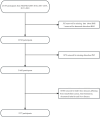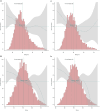Association of obesity with osteoporotic fracture risk in individuals with bone metabolism-related conditions: a cross sectional analysis
- PMID: 39166135
- PMCID: PMC11333327
- DOI: 10.3389/fnut.2024.1365587
Association of obesity with osteoporotic fracture risk in individuals with bone metabolism-related conditions: a cross sectional analysis
Abstract
Introduction: This study aimed to investigate the individual and composite associations of different indices of obesity on osteoporotic fractures at three different sites among individuals affected by conditions influencing bone metabolism.
Methods: Participants were included from the National Health and Nutrition Examination Survey (NHANES), a national cross-sectional survey. BMI and WC were used separately and in combination to evaluate the presence of obesity. Obesity was defined as BMI ≥ 30 kg/m2, WC ≥ 88 cm in females, and WC ≥ 102 cm in males. Associations between obesity and osteoporotic fractures were assessed using multivariable logistic regression and OR curves. Associations modified by age, sex, race, and alcohol consumption were also evaluated.
Results: A total of 5377 participants were included in this study. In multivariable logistic regression analyses, we found that BMI, WC, BMI defining obesity, and WC defining obesity were negatively associated with hip fracture (all p < 0.05). However, harmful associations between WC and BMI defining obesity and spine fracture were found (all p < 0.05). OR curves revealed that BMI and WC had a linear relationship with hip and spine fractures (all P for non-linearity >0.05). Further analyses showed that the highest WC quartile was harmfully associated with a higher risk of spine fractures (p < 0.05). Obese participants diagnosed by both BMI and WC were less likely to have hip fractures but more likely to have spine fractures (all P for trend <0.05). A significant interaction between age (Ref: age < 50 years) and BMI and WC was detected for hip fractures (all P for interaction <0.05).
Discussion: In people with conditions influencing bone metabolism, obesity diagnosed by BMI and WC was associated with a lower risk of hip fracture, while obesity diagnosed by BMI and the highest WC quartile were associated with a higher risk of spine fracture.
Keywords: BMI (body mass index); WC (waist circumference); bone metabolism; obesity; osteoporotic fractures.
Copyright © 2024 Yang, Jiang, Xie, Yuan, Wu, Zhang, Zhang, Yuan, Lin, Chen and Yin.
Conflict of interest statement
The authors declare that the research was conducted in the absence of any commercial or financial relationships that could be construed as a potential conflict of interest.
Figures



Similar articles
-
Risk of Osteoporotic Fractures Among Obese Women Based on Body Mass Index and Waist Circumference: A Nationwide Cohort in South Korea.Clin Nutr Res. 2022 Feb 7;11(1):32-41. doi: 10.7762/cnr.2022.11.1.32. eCollection 2022 Jan. Clin Nutr Res. 2022. PMID: 35223679 Free PMC article.
-
Added value of waist circumference to body mass index for predicting fracture risk in obesity: a prospective study from the CARTaGENE cohort.Arch Osteoporos. 2023 Jul 7;18(1):92. doi: 10.1007/s11657-023-01302-1. Arch Osteoporos. 2023. PMID: 37420039
-
Associations between weight-adjusted waist index and fractures: a population-based study.J Orthop Surg Res. 2023 Apr 10;18(1):290. doi: 10.1186/s13018-023-03776-8. J Orthop Surg Res. 2023. PMID: 37038167 Free PMC article.
-
Relationships between Obesity and Incidence of Fractures in a Middle-Aged Population: A Study from the CARTaGENE Cohort.JBMR Plus. 2023 Mar 3;7(5):e10730. doi: 10.1002/jbm4.10730. eCollection 2023 May. JBMR Plus. 2023. PMID: 37197317 Free PMC article.
-
Associations of abdominal obesity with different types of bone fractures in adults: A systematic review and dose-response meta-analysis of prospective cohort studies.Crit Rev Food Sci Nutr. 2024 Jun;64(18):6239-6250. doi: 10.1080/10408398.2023.2166456. Epub 2023 Jan 19. Crit Rev Food Sci Nutr. 2024. PMID: 36655423
References
LinkOut - more resources
Full Text Sources

